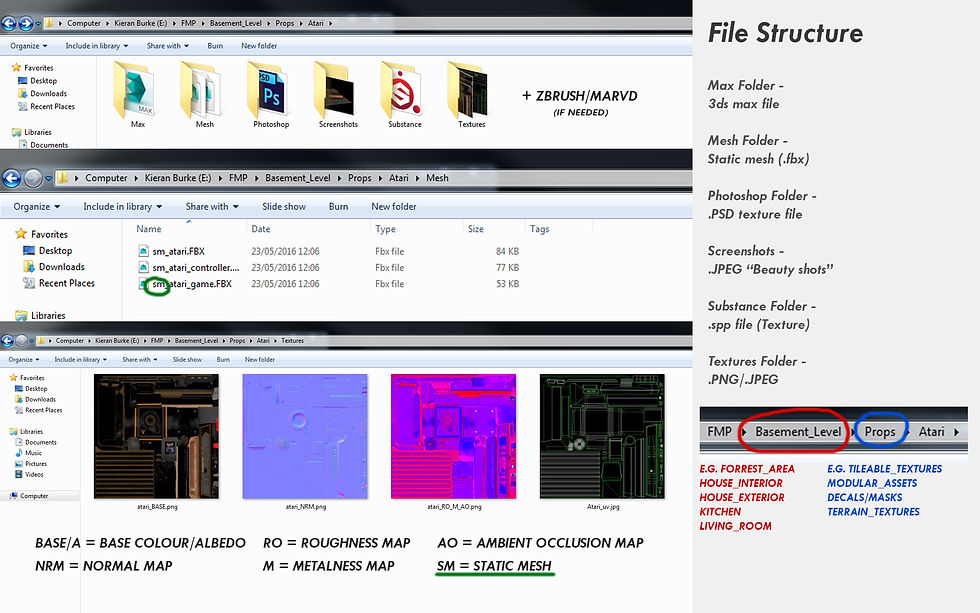FMP: Post Mortem
- kieran128
- May 31, 2016
- 7 min read
For the past 20 or so weeks I have been working on my final major project. This project is the last I will do here at university, it is worth a substantial amount of marks for my overall grade, and it is also what I will be presenting at the end of year degree show in a few weeks. In essence, it is a visual representation of my three years studying game art design. Unlike previous projects I completed, this one asks for us to write up the brief ourselves, so what we will be doing, and how we want it to be graded.
Early on before the start of the project I decided that I would prefer to work with another person on this project. It’s very rare in the game industry you work by yourself, I believed it would be good practice in organising and communication if I worked with someone else. Calum Bellis, also an environment artist was my first choice. Having worked with him on the Alice in Wonderland Project last year knew his workflow, how well we worked together along with his skills and weaknesses. Both being environment artists we share the same skills, but also we each have skills the other does not. With this larger skills set we were able to accomplish more than what we would by ourselves.
As always in group projects there are ups and downs, there have been several times where we have disagreed with each other. However we were able to communicate with each other and compromise on certain aspects of the project. It also helped work-wise, knowing someone else relies on you doing your part of the project is a solid form of motivation.
Once we had decided we would be working together we wrote up our brief to play to our strengths. The project itself was to create a highly detailed game level. The environment was designed to be made up of three distinct areas that would show case the skills we had acquired over the past three years. The theme was Russian spies in the 70’s, giving the project a theme helped concentrate what needed to be done.
The first area, North American woodlands. This area (the largest of the three) was used to showcase are ability to model realistic foliage and simulate realistic outdoor lighting. For this section of the project we both divided the work that needed to be done evenly. Again we made sure to play to our strengths for this section of the environment. Calum was in charge of the terrain textures and setting up the materials to work with vertex painting while I was in charge of lighting the area and the placement of assets, and of course, we were both responsible for the foliage assets.

This first area of the environment was quiet a struggle, I can actually say it is the stage I was most fed up with during the project. Creating convincing foliage is a difficult task to complete, thankfully we had gathered a substantial amount of research before starting the area. Having just returned from San Francisco I gathered several dozen reference images from both Muir Wood and Yosemite national park. A large majority of the outside area is based on real world reference for this reason there was little design for this stage. With this said, there was still a design process we underwent. Most of the design process was completed in the form of trial and error. For example during asset placement and lighting I went on several passes until it looked both what we agreed we wanted it to look like, and also accurate to the reference images we had collected. The assets were selected from an asset list dependent on how aesthetically pleasing they were and also how convincing they would look once placed in the environment.





The second area, the house interior. This area of the project felt like the longest stage due to the large number of work and general assets we put in. for this area we decided we should have a small section we could each call our own. With both the outside and the basement area being a mismatch of assets we both worked on, we decided to each have a room in the house interior we would work separately on. There are still on or two assets that jump between rooms, but the majority of the rooms were completed separately. I was responsible for the living room.



Before working on something I enjoy a quick warm up. I flick through a furniture catalogue and choose to create something, I’ve been doing this since first year. Over the past few years I’ve gotten pretty fast and efficient with modelling furniture, this really helped with the interior part of the level. This area of the project in my opinion was the best part. I enjoy games like The Sims where you’re able to dress a set with several dozen assets. Once I had created all the assets on my list placing them in the environment was essentially a game to me. Similar to the outdoor area I went through a trial and error process while placing assets in engine and also lighting the scene.

With the interior, I drew up and designed several layouts to use for the house interior. I took into account the placement of important assets, lighting and also the path the player would walk to traverse the house. I made sure to block of areas and paths to force the player in walking a specific route to experience the environment how I wanted them to. This was to make sure some of the more specific assets aren’t missed. The purpose of the house interior was the showcase the lighting change between outdoors and indoors, I also believe the Living room/house as a whole shows off meaningful assent placement throughout, another skill I wanted to come across through this environment.
During this stage of the project I was given an art test from Foundry 42 which unfortunately took almost 2 weeks out of FMP. Thankfully the test wasn’t in vein, I believed it helped me prepare for the final area of the level, it was also good practice for hard surface modelling and I also got a job from it.

Finally, the last area of the project was the basement. This area had the most deign put into it. As the other two were based on places in real life little design was needed. However, for a secret spy basement such as this, a little more though over how things looked was needed. During the first week of this stage of the project both Calum and I drew up rough sketches of what this area could look like. At one point we came up with an old 16th century styled architecture styled basement, however this did not make a sense in the world we were making. Final we decided on a more solid concrete styled basement. With the help of reference images and a piece of concept drawn up by Lewis Jones we were able to get straight into the modelling for this area.

Similar to the house interior this stage of the project for me consisted of choosing assets from an asset list I wrote down before the start and simply going through each one. I believe this area was the shortest in terms of time. Needing to go back and fix the other areas, we had to reduce the size of the basement by quite a bit. With this being said, I still believe its purpose still comes through even though it’s almost half the size of what it should have been. Similar to the second area, the basement’s purpose is to show case a changing narrative and meaningful asset placeman. Out of the three areas I want to say this one came out the best. This may have been because we spent a little more time on designing it ourselves rather than basing it on already established material.


Overall I believe the project a whole to be a great success. There were many times when we would disagree on something or fall behind on work, but we were able to pull it back at the end. The biggest weakness I would have to say for this project (speaking for myself) was my knowledge of unreal engine. There were several times I lost momentum due to an error or simply not knowing what to do with the engine. Thankfully as I mentioned at the start we each had skills the other did not, it helped that when I did come across a wall I could simple turn to Calum and ask for help. What went well with the project is the amount of detail. I spent a lot of time modelling and texturing hundreds of assets, all unique, all add to the changing narrative of the environment one way or another.
It’s actually gotten to the point that when we’ve gotten people to test our level they miss all the small details that I’ve put in, it’s a little bit disappointing but maybe it is just a testament to how much I’ve actually put into the level. I spent the last week of the project putting together a flythrough of the level, I had to cut out several section as they simply would fit. I don’t think there is anything I would have done differently. We planned for setbacks and falling behind, which we were able to make back at the end of the project. We completed exactly what we said we would do.



This project has taught me how to organise large projects, I’ve learnt how to communicate my point across and also how to compromise. The project has solidified what I’ve learnt during my 3 years at uni. I’ve become a more confident modeller, I’ve become skilled in several programs and I’ve also picked up a couple new skills over the course of this project..
























Comments